INDEPENDENT meat and livestock industry analyst Simon Quilty thinks Meat & Livestock Australia’s recent 2023 beef herd estimate may be close to three million head too high.
Mr Quilty, from Global Agritrends, is one of a number of industry stakeholders who have raised questions about the herd estimate over the past week.
“I cannot overstate how important it is that MLA gets these numbers right,” he said.
“It is misleading to have herd size numbers that don’t make sense. Over-inflated figures send the wrong market signals globally and lead to poor decisions on-farm and off-farm by those who believe them,” Mr Quilty said.
As our report yesterday pointed out, MLA’s 2023 Industry Projections have the national beef herd hitting 28.8 million head this year – the largest herd seen since 2014 – before peaking at 29.6 million in 2025, which would make it the largest in 46 years.
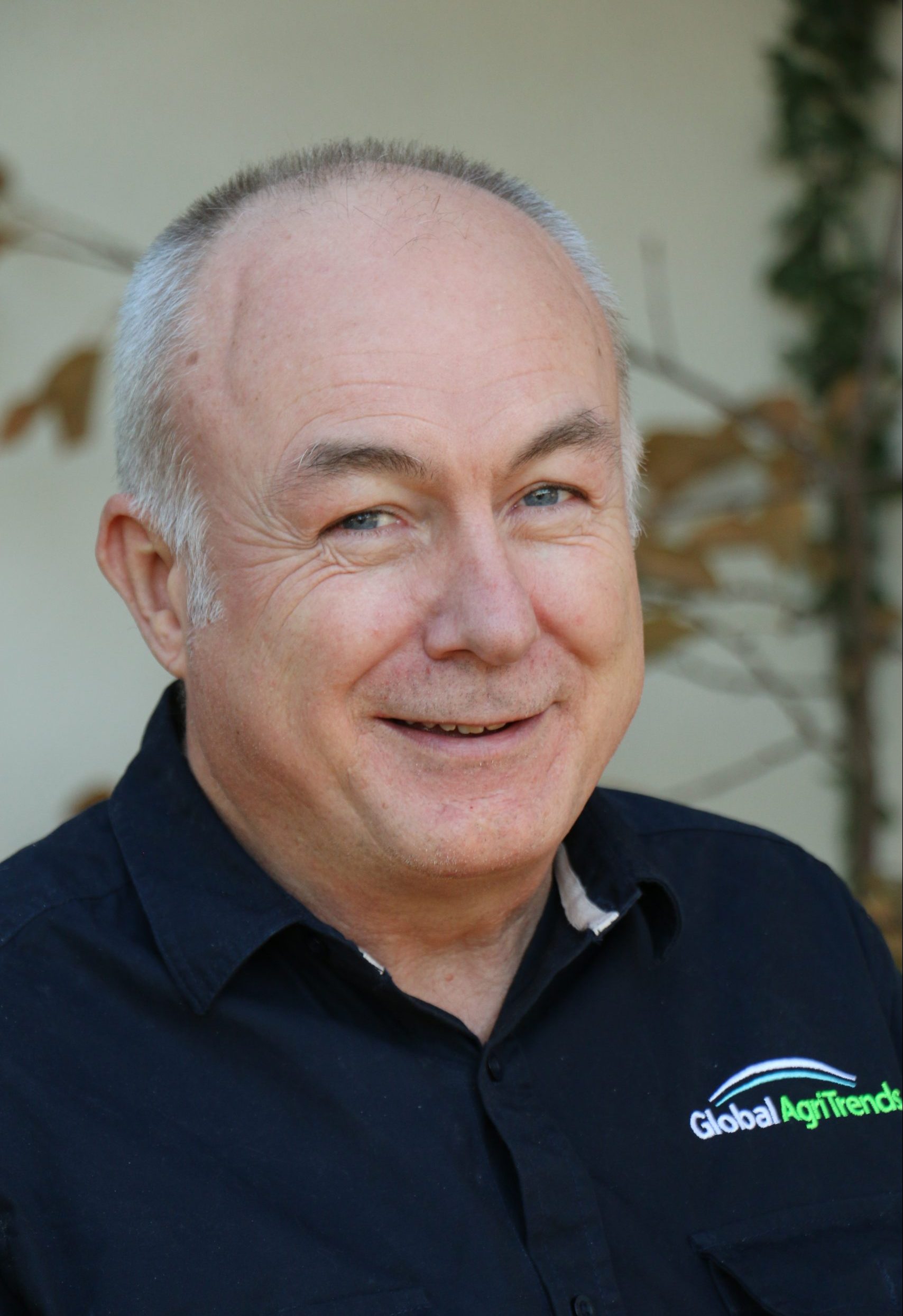
Simon Quilty
“I believe these numbers are grossly overstated,” Mr Quilty said.
“It implies that a wall of cattle and meat is inevitable from Australia over the next three years.”
“This would signal buyers worldwide to stop buying forward and wait for the meat offerings to come to them from Australia. This could not be further from the truth, and the evidence points to a long-term trend of falling cattle inventory, not an expansion,” he said.
Starting with correct numbers
Mr Quilty said it was critical in any analysis to start with the most accurate numbers possible in data.
“To me, the Australian Bureau of Statistics has the most accurate hard numbers, with quarterly production, slaughtering and carcase weights – these are actuals, not guesstimates. In addition, ABS does a yearly cattle and sheep inventory and, once again, the most accurate numbers available.”
There was much speculation on Australian livestock numbers, but every five years when the national census is done (2020/21 data was a census year), a large pool of 125,000 farmers is surveyed, Mr Quilty said.
“This is the most accurate reading. The in-between years are done with a much smaller pool of farmers, and therefore provide not as strong a number as a census year survey – but it is still an excellent guide and estimate. These ABS figures are what all analysts use and have for 40 years.”
ABS figures for June 2021/22 were released two weeks ago, and saw a 1pc increase in Australia’s beef herd and a 10pc decline in Australia’s dairy herd for last year. Australia’s net herd (beef+dairy) in 2021/22 saw a 0.13pc decline.
“I am unsure why MLA has put this number at a 6pc increase,” Mr Quilty said. ”This is a ‘hard’ actual number and should be the starting point of their analysis.”
“Regardless of whether the ABS used an EVAO (estimated minimum value of agricultural operations) of $5000 or $40,000, the herd fell in Australia by 0.13pc in 2022 and either number of EVAOs should reflect this.”
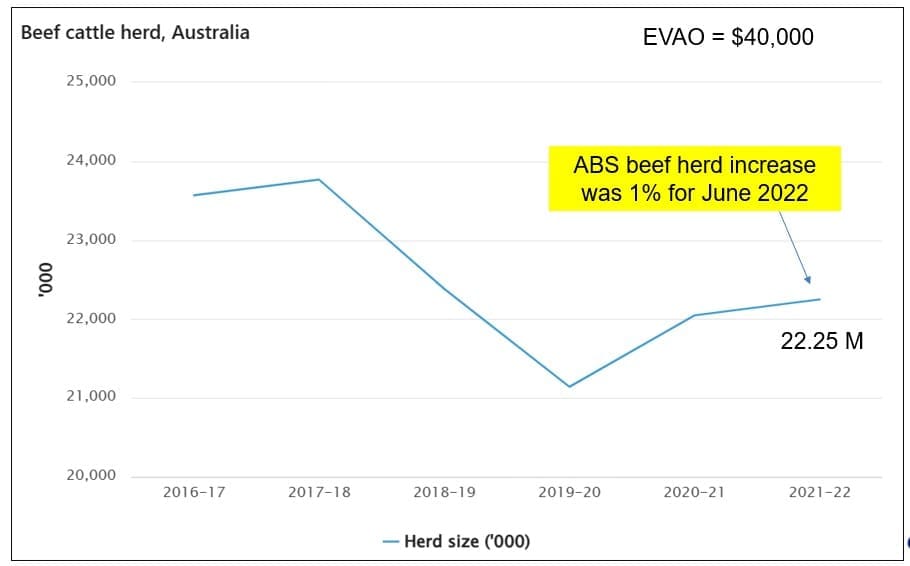
The dairy herd in Australia has been declining for several years due to several reasons, including the lack of labour and the unwillingness of other younger generations to continue with dairying.
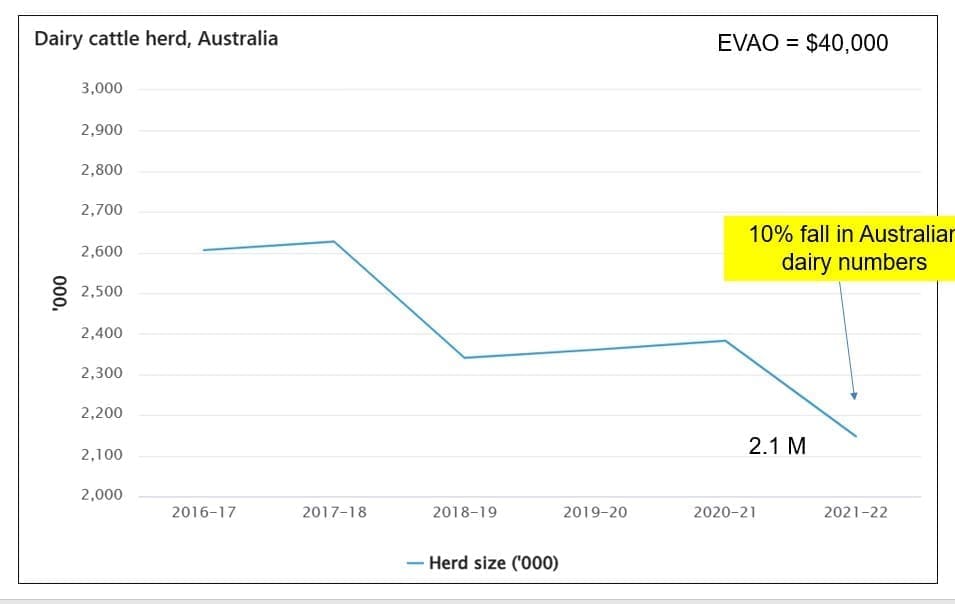
QLD, Australia’s beef engine room is spluttering
Australia’s largest beef production state has struggled to expand its herd, with only a 2pc increase to 10.8 million head, and the previous year saw only a 2.1pc increase in size, Mr Quilty said.
There were many reasons for this slow rebuild, including:
- The migration into NSW of almost 700,000 head of Queensland cattle in 2020, as NSW looked to rebuild by buying cattle from all other states around Australia. The majority of these were female.
- Large parts of western QLD have now reverted to sheep and goats, marginal land that simply could not carry cattle during the last drought. Exclusion fencing has seen hundreds of thousands of hectares in marginal areas of QLD and NSW revert to sheep and goats.
- The losses of the Northern Australia floods in 2019 have seen a challenging time to rebuild after an estimated 500,000 head was lost. However, large areas of pasture land have yet to recover, and the carrying capacity has been compromised.
- In 2021, ABS land survey results had 4 million ha of grazing land in QLD taken out of the system due to non-agricultural demands such as Defence, conservation and indigenous aboriginals reclaiming land. In each instance, livestock did not go back onto this land.
- Much of QLD was at least six months later in emerging from drought than southern Australia.
“For MLA’s numbers to be correct, it would require Queensland to be at ‘full throttle’ for a rebuild to occur at the rate they claim, as was seen back in the 2012 to 2013 period, which had QLD expand at 6.7pc, which led to the 29.29 million head that year,” Mr Quilty said. “This simply has not and will not occur.”
“It is, therefore, no surprise to me when ABS 2022 figures showed that Australia’s beef herd expanded by only 1pc and the dairy herd contracted by 10pc. This has been driven by structural change, not weather, and therefore is likely to see this stunted herd growth continue.”
Mr Quilty’s own analysis is based on the same Estimated Value of Agricultural Operations (EVAO) as MLA – i.e. $5000 per enterprise, which captures all the smaller operations.
MLA slaughter figures versus herd size do not add up
When comparing the slaughter figures against herd size, even during a rebuild, there was natural attrition that happens, Mr Quilty said. Not all females are held back, a certain percentage come to market because of age, poor performance and routine management decisions.
The last time the herd was at similar levels to MLA’s forecast was in 2013, 2014, and 2015 – these years giving an excellent guide to what slaughter levels should be under MLA’s 2023, 2024 and 2025 projections.
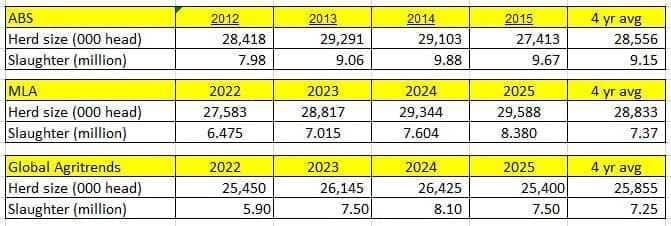
All data in the table above is based on a $5000 EVAO, including ABS, GAT and MLA – in other words, comparing ‘apples with apples.’
“Strangely the slaughter levels MLA have presented, are ‘doable’, but do not represent a herd average of 28.8 million over four years. They represent a herd size of three million less, or closer to 25.85m (GAT forecast).The MLA ratios simply do not make sense,” Mr Quilty said.
The period 2012-2015 saw a lower national herd size average of 28.55m head, but a slaughter level that was 24pc higher, he said.
“Given that today’s herd is younger and more efficient, it would imply that with a large herd size, more cattle – not less – would be slaughtered annually. I would have expected a greater slaughter than the 2012-2015 period.”
“Either the MLA cattle herd is too high, or the slaughter level is too low. I think it’s the former,” he said.
Two scenarios – A wall of meat produced or cattle prices plummet in Australia.
Staying true to MLA’s herd size forecast and using the more realistic slaughter levels of the 2012-2015 period, and using MLA’s forecast carcase weights, Mr Quilty says would see a ‘ballooning out’ of beef production by 33pc compared to MLA’s current forecasts, and compared to 2022 production estimate a 43pc increase over the following three years – a figure that was not true.

Two events are likely when such a large herd is projected:
- Either a wall of meat will result and, therefore, significant exports would occur that would be 60pc higher than last year’s 2022 estimate, or
- If the industry does not have the labour resources, a catastrophic crash in cattle prices as numbers surge and cattle come forward, particularly if conditions are dry.
“Since last year’s high Australian feeder prices have fallen 33pc, but such large numbers and limited labour would potentially see another 60pc fall, taking prices back to 2012-2015 levels,” Mr Quilty said.
“Either scenario will not occur, but when such inflated herd sizes are given, this is the apparent conclusion the market will reach.”
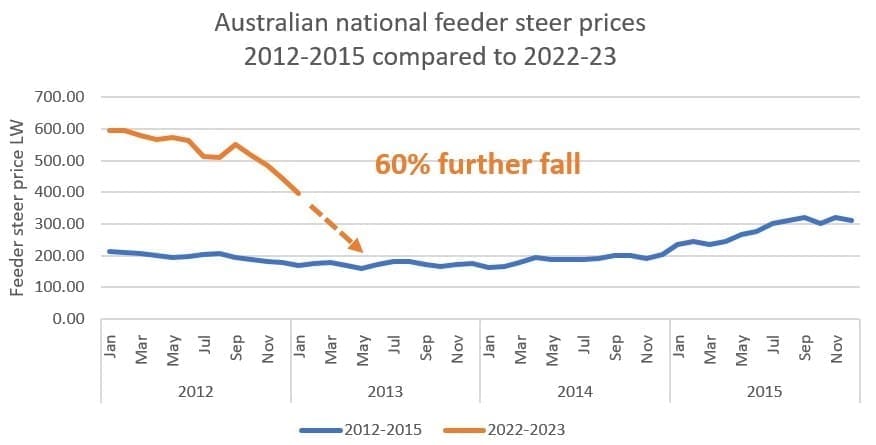
Consequences of reporting misleading numbers
The consequence of telegraphing such enormous numbers was that it tells all our overseas markets that large volumes of meat from Australia are likely, and customers stop buying, Mr Quilty said.
“Buyers will stop giving forward prices and wait as they know the meat will eventually come to them. Such a large herd size indicates that an overwhelming volume of meat is on its way.”
Such an event was particularly worrying for Wagyu and longfed Angus feeding programs, as selling forward over six to twelve months was crucial in offsetting risk with cattle on feed for such extended periods, he said.
Mr Quilty’s other concern was the impact on investment decisions.
“Such large cattle numbers would tell processors to expand capacity further, yet in reality; the herd is in a long-term decline,” he said.
“Droughts, competition for land, environmental constraints, and limited labour is seeing cattle numbers getting less, not more. I do not deny that cattle numbers will increase next year, but the peaks in each cattle supply cycle are getting lower.”
Poor forecasts based on rubbery figures led to poor decisions on investment and strategy, he said.
“Cattle producers seeing such large cattle inventory numbers would be deeply concerned about further price falls should dry conditions and large turnoffs happen. This could lead to panic selling as farmers would be worried about ‘the wall of cattle’. This could not be further from the truth,” Mr Quilty said.
He said he was confident that come 2025 and 2026, Australia would see record cattle prices due to a much smaller herd and strong global prices.
“These MLA numbers would imply the opposite.”
“In reality, the cattle numbers are not there, and as an industry, we need farmers to be patient and manage their herds through droughts, not panic and ensure our industry remains viable.”

MLA seems more influenced by the buyers of cattle than the producers of cattle.
Nothing has changed.
One day, cattle producers (who pay millions to MLA every year), will find a way to ensure MLA exists to support its majority shareholders.
A real challenge for Cattle Australia and other commodity organisations.
Begs believe that MLA could be so fundamentally wrong in their calculations.I think I’d rather give my levees to Mr Quilty to administer on this result!!
Well argued Simon demonstrates what happens when experience and common-sense are applied. MLA forecasts habitually vary between the sublime and ridiculous courtesy of producer levies !
I’m not sure i agree with Mr Quilty’s take on higher cattle prices in 2025 and 2026.
I firmly believe the high prices we were seeing is a direct result of “Cheap money” and restocking demand creating a perfect storm for cattle prices. I think in the short to medium term we will see prices trend downwards as they are doing currently, bottoming out around that $2.50 to $3.50 setting the price about where it should have been if not for the Covid madness that drove prices to the moon.
Higher interest rates will push cattle to market with the price inline with demand and processor capacity.
Thank you Mr Quilty for writing this on true factual figures & common sense. Over inflated guesstamations & the consequences of that eg, lower cattle prices after such high prices for stock & land causes untold mental health issues.
Another reason why our donations to mla are pointless. We would be better off as an industry if we all chipped in for simons wages. The balance, calmness, reasoning and content this man provides is unmatched. Cheers Matthew Della Gola
Would be good for Beef Central to interview MLA and Simon together on this soon.
Nice idea Greg – but unfortunately Simon is about to head overseas on a Churchill fellowship, for several months. We’ll be following his visits, looking at different country’s approaches to carbon/methane, during his trip. Maybe we can circle back after he returns. Editor
Greg Popplewell I’ll second that.
Thanks might have to be an Internet hosted interview
Thank you for the very well reasoned and factual paper today.
That was something badly needed.
Many people do not realise the potential damage being caused by the commonly considered unfortunate miscalculation.
I have had a number of highly recognised industry participants compare thoughts with all a little dumbfounded as to the forecast numbers and the potential damage to those marketing to offshore customers.
Thank you for highlighting for all to consider.
Appreciate the content and detail of Quilty’s perspective as clearly explained in the Jon Condon article of February 8th. This is a vitally important subject to the industry as a whole. There is a method to the ABS numbers, over a variety of reliable collection points and as consistently laid out over several years. Quilty refers to Land Use change, particularly in QLD, the Beef HQ of Australia which in and of itself is a serious signal as to carrying capacity. Consider also exceedingly high grain prices the past few years which may have impacted the farming decisions, cropping vs grazing.